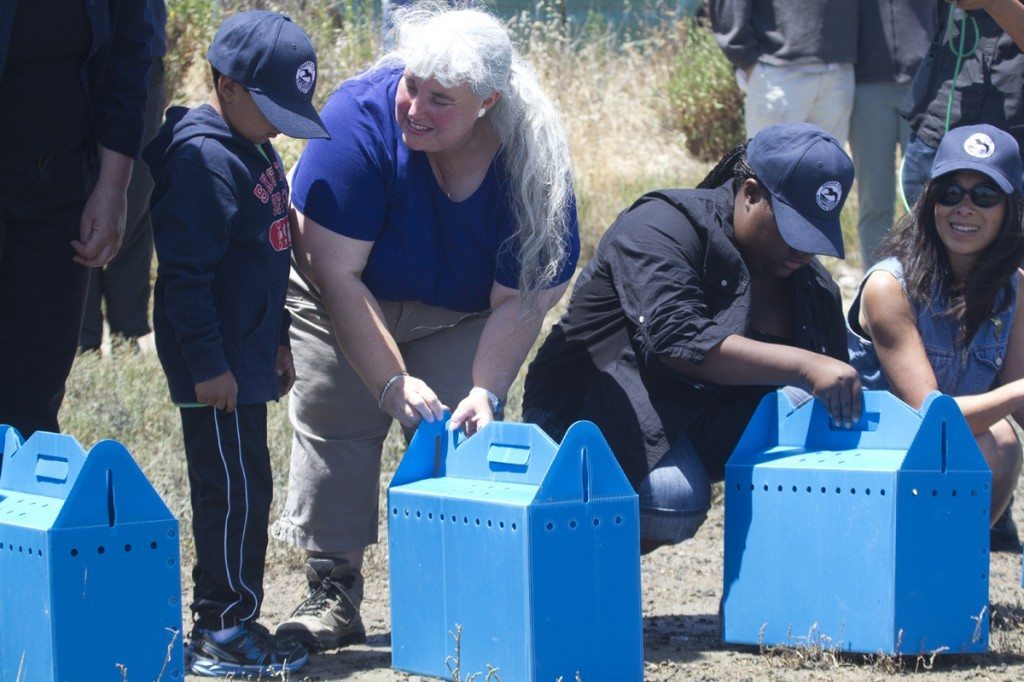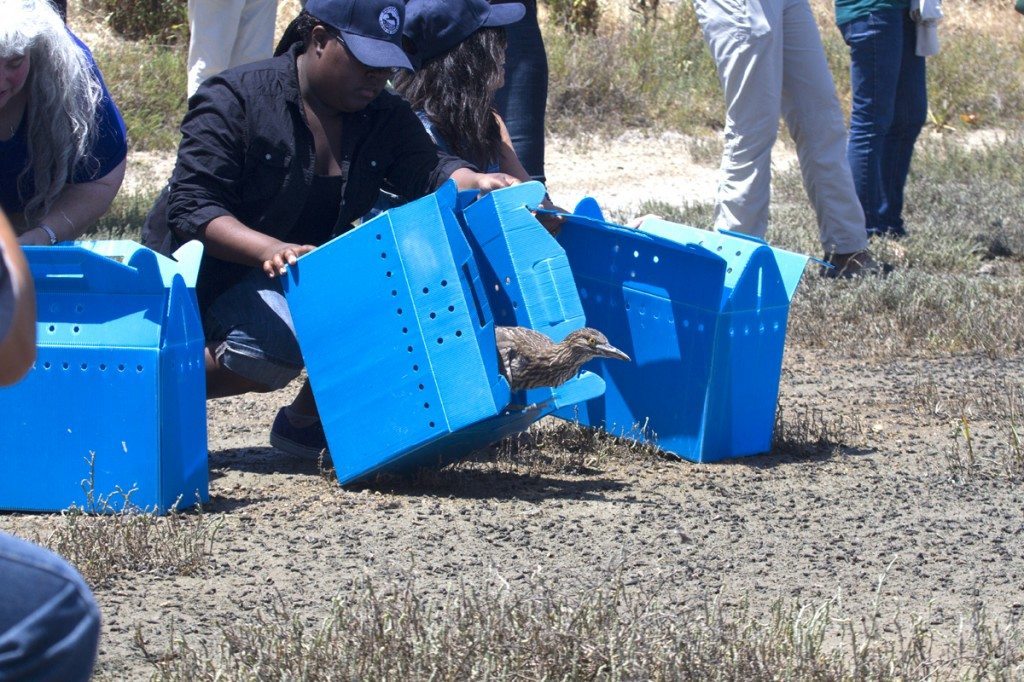Oakland Night-Herons released at MLK Shoreline
By Ilana DeBare
Golden Gate Bird Alliance joined International Bird Rescue on Saturday to release four of the juvenile Black-crowned Night-Herons that had been displaced and injured in a downtown Oakland tree trimming incident that drew national attention.
Five young herons had been rescued by volunteers in May when the U.S, Postal Service hired tree trimmers to prune trees filled with heron and egret nests — a violation of the federal Migratory Bird Treaty Act of 1918, as well as state laws protecting birds.
After weeks of care, including treatment of one bird for a fractured mandible, four of the five herons were healthy and mature enough for release into the wild. GGBA Executive Director Cindy Margulis — who had done heron releases with IBR before as a volunteer there — identified a site in the New Marsh section of Martin Luther King Jr. Shoreline Park.
GGBA also recruited some young birders — including two from our Eco-Oakland program, which provides hands-on nature education in the Oakland public schools — to open the crates for the birds.

More than two dozen volunteers, bird photographers and news reporters gathered at the release site. The mood was upbeat and excited. We spend so much of our time on long, complex battles over threats like habitat loss and wind turbines that it was exhilarating to watch the simple return of young birds to a welcoming habitat.
And New Marsh was a particularly appropriate site. Not only is it prime foraging habitat for herons, but its continued existence is due to a successful battle waged by GGBA and our allies in the 1980s and 90s. The Port of Oakland had been trying to develop that area; we sued, and as part of the settlement, won the preservation of 73 acres of marsh. Today GGBA volunteers continue to restore habitat at MLK Shoreline, and our Eco-Oakland program uses the park as an outdoor classroom.
IBR and GGBA staff carried the blue transport crates into the fenced-off New Marsh area. The news media formed a semicircle at a safe distance. The kids opened the crates.



One bird leaped out and flew immediately over our heads to roost in some trees. Four others stepped out more gingerly….
And were greeted by the roaring engines of some 30 motorcyclists on a weekend ride through the park!
Ah, the challenges of working with urban wildlife.



Fortunately, the herons seemed less agitated by the burst of engines than their human rescuers did. They looked around, walked a little bit away, looked around some more, and eventually settled into foraging in one of the ponds in the marsh.
The released herons all have white leg bands. If you’re birding at MLK Shoreline or nearby Bay Farm island (where a lot of herons roost), keep an eye out for the white band!
Meanwhile, Ernesto Pulido — the tree trimmer who initially displaced the birds — joined us shortly after the release. Pulido, who helped pay for the birds’ rehabilitation, was gratified to see them safely back in the wild. He also offered to help us spread the word among other tree trimmers about protecting birds during tree care.
We used the occasion of the release to announce publication of our new brochure, Healthy Trees, Healthy Birds, about how to identify and protect nests during tree care.
With support from The Britton Fund, this brochure had been in the works for several months before the Oakland night-heron incident. But the Oakland incident provided a wonderful “teachable moment” around birds and tree care, allowing us to highlight the fact that it is illegal to destroy or disturb nests. This is our nano-second in the media spotlight — and these new brochures will help us spread the word. Our next step will be to translate the brochure into Spanish, the primary language of many workers in the landscaping and tree care community.
Another “next step” will be organizing some kind of docent program to protect and educate people about the heron rookeries in downtown Oakland. In Santa Rosa, where there is a large urban rookery, wildlife lovers have taken steps like cordoning off the street directly under nesting trees and placing hay bales there to provide a soft landing for young birds that fall out of the trees.
We are also continuing to look into the role of the U.S. Postal Service in the Oakland trimming incident. It is an unfortunate irony that Mr. Pulido — a 26-year-old individual tree trimmer without a lot of financial resources — stepped up and took more responsibility than this giant federal agency did. We hope this is not the end of the story when it comes to the Post Office being held responsible for its actions.
————————
Would you be interested in helping with a docent program to protect and educate about the downtown Oakland herons? We’d like to get this in place before next year’s nesting season. Please email us at volunteer@goldengatebirdalliance.org.
Download our Healthy Trees, Healthy Birds brochure and share it with your gardener or landscaper! Or pick up a copy at our office or at the next GGBA Speaker Series. We also have a new section of our web site with extensive information on birds and tree care, including descriptions of different kinds of nests, the laws protecting birds and nests, and how to plan your tree care project. See goldengatebirdalliance.org/treecare.
Many thanks to everyone who made it possible for these birds to recover and return to the wild, including the neighbors and volunteers who rescued them; WildCare; International Bird Rescue; and East Bay Regional Park District.



